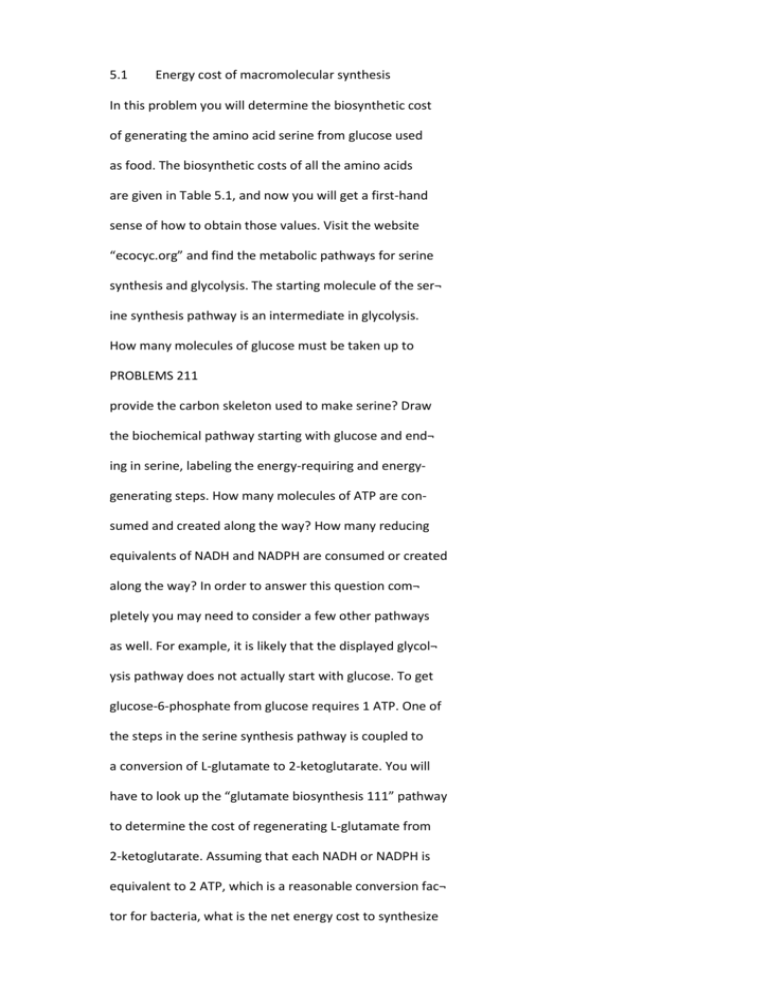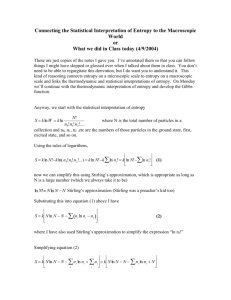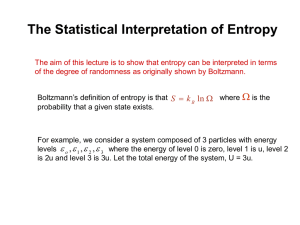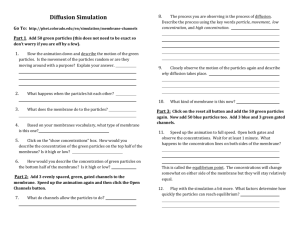5.1 Energy cost of macromolecular synthesis In this problem you will
advertisement

5.1
Energy cost of macromolecular synthesis
In this problem you will determine the biosynthetic cost
of generating the amino acid serine from glucose used
as food. The biosynthetic costs of all the amino acids
are given in Table 5.1, and now you will get a first-hand
sense of how to obtain those values. Visit the website
“ecocyc.org” and find the metabolic pathways for serine
synthesis and glycolysis. The starting molecule of the ser¬
ine synthesis pathway is an intermediate in glycolysis.
How many molecules of glucose must be taken up to
PROBLEMS 211
provide the carbon skeleton used to make serine? Draw
the biochemical pathway starting with glucose and end¬
ing in serine, labeling the energy-requiring and energygenerating steps. How many molecules of ATP are consumed and created along the way? How many reducing
equivalents of NADH and NADPH are consumed or created
along the way? In order to answer this question com¬
pletely you may need to consider a few other pathways
as well. For example, it is likely that the displayed glycol¬
ysis pathway does not actually start with glucose. To get
glucose-6-phosphate from glucose requires 1 ATP. One of
the steps in the serine synthesis pathway is coupled to
a conversion of L-glutamate to 2-ketoglutarate. You will
have to look up the “glutamate biosynthesis 111” pathway
to determine the cost of regenerating L-glutamate from
2-ketoglutarate. Assuming that each NADH or NADPH is
equivalent to 2 ATP, which is a reasonable conversion fac¬
tor for bacteria, what is the net energy cost to synthesize
one molecule of serine in units of ATP and units of kBT?
5.2 The sugar budget revisited
In Chapter 3 we worked out the rate of sugar uptake
to provide the construction materials for a dividing
bacterium. However, as shown in this chapter, sugar
molecules also provide the energy needed to perform
macromolecular synthesis. Amend the estimate of Chap¬
ter 3 to include the fact that sugar supplies construction
materials and the energy needed to assemble them. You
might find it useful to look at the macromolecular energy
costs revealed in Table 5.2. How many sugars are needed
to provide the energy and construction materials for
making a new cell? Make an estimate for the average rate
of sugar uptake for a dividing bacterium in light of this
amendment to our earlier estimates.
5.3 A feeling for the numbers: covalent bonds
(a) Based on a typical bond energy of 150 kB T and a typical
bond length of 1.5 A, use dimensional analysis to estimate
the frequency of vibration of covalent bonds.
(b) Assume that the Lennard-Jones potential given by
describes a covalent bond (though real covalent bonds are
more appropriately described by alternatives such as the
Morse potential which are not as convenient analytically).
Using the typical bond energy as the depth of the poten¬
tial and the typical bond length as its equilibrium position
find the parameters a and b. Do a Taylor expansion around
this equilibrium position to determine the effective spring
constant and the resulting typical frequency of vibration,
(c) Based on your results from (a) and (b), estimate the
time step required to do a classical mechanical simulation
of protein dynamics.
5.4
Taylor expansions
(a) Repeat the derivation of the Taylor expansion for cos x
given in the chapter, but now expand around the point
x = 7r/2.
(b) Do a Taylor expansion of the function e* Ground zero.
Generate a plot of the fractional error as a function of x for
different orders of the approximation and a comparison
of the function and the different order expansions such
as was shown in Figure 5.20.
(c) A one-dimensional potential energy landscape is given
by the equation f(x) = x4 - 2x2 - 1. Find the two minima
and do a Taylor expansion around one of them to second
order. Show the original function and the approximation
on the same plot in the style of Figure 5.19.
5.5
A feeling for the numbers: comparing multi¬
plicities
Boltzmann’s equation for the entropy (eqn 5.29) tells us
that the entropy difference between a gas and a liquid is
given by
Sgas ~ Sliquid = kB ln-J^.
(5.61)
"liquid
From the macroscopic definition of entropy as dS = dQ/T
we can make an estimate of the ratios of multiplicities by
noting that boiling of water takes place at fixed T at 373 K.
(a)
Consider a cubic centimeter of water and use the result
that the heat needed to boil water (the latent heat of vapor¬
ization) is given by Qvaporization = 40.66 kj/mol (at 100 °C)
to estimate the ratio of multiplicities of water and water
vapor for this number of molecules. Write your result as
10 to some power. If we think of multiplicities in terms of
an ideal gas at fixed T, then
What volume change would one need to account for the
liquid/vapor multiplicity ratio? Does this make sense?
(b)
In the chapter we discussed the Stirling approxima¬
tion and the fact that our results are incredibly tolerant
of error. Let us pursue that in more detail. We have found
that the typical types of multiplicities for a system like
a gas are of the order of W ^ exp(1025). Now, let us say
we are off by a factor of io1000 in our estimate of the
multiplicities, namely, W = io1000exp(1025). Show that
the difference in our evaluation of the entropy is utterly
negligible whether we use the first or second of these
results for the multiplicity. This is the error tolerance that
permits us to use the Stirling approximation so casually!
5.6
Stirling approximation revisited
The Stirling approximation is useful in a variety of differ¬
ent settings. The goal of the present problem is to work
through a more sophisticated treatment of this approxi¬
mation than the simple heuristic argument given in the
chapter. Our task is to find useful representations of n\
since terms of the form In n\ arise often in reasoning about
entropy.
(a) Begin by showing that
TOO
n! = x"e~*dx.
Jo
(5.63)
To demonstrate this, use repeated integration by parts. In
particular, demonstrate the recurrence relation
poo
poo
xne~*dx = 77
Jo
x”_1e_*dx,
(5.64)
Jo
and then argue that repeated application of this relation
leads to the desired result.
(b) Make plots of the integrand xne~x for various values
of 77 and observe the peak width and height of this inte¬
grand. We are interested now in finding the value of x for
which this function is a maximum. The idea is that we will
then expand about that maximum. To carry out this step, consider ln(x"e~x) and find its maximum argue why it is
acceptable to use the logarithm of the original function as
a surrogate for the function itself - that is, show that the
maxima of both the function and its logarithm are at the
same x. Also, argue why it might be a good idea to use the
logarithm of the integrand rather than the integrand itself
as the basis of our analysis. Call the value of x for which
this function is maximized xq. Now expand the logarithm
about *o-]n particular, examine
In [(xo + 5)"e"(Xo+S)] = n In (x0 + 5) - (*o + &)
(5.65)
and expand to second order in <5. Exponentiate your result
and you should now have an approximation to the orig¬
inal integrand which is good in the neighborhood of *oPlug this back into the integral (be careful with limits of
integration) and by showing that it is acceptable to send
the lower limit of integration to -oo, show that
COO
?
n\
e"s
/2”d<5. (5.66)
J—OO
Evaluate the integral and show that in this approximation
n\ = n"e“"(27rH)1/2.
(5.67)
Also, take the logarithm of this result and make an argu¬
ment as to why most of the time we can get away with
dropping the (27tn)l/2 term.
5.7
Counting and diffusion
In this chapter, we began practising with counting argu¬
ments. One of the ways we will use counting arguments
is in thinking about diffusive trajectories.
Consider eight particles, four are black and four are white.
Four particles can fit left of a permeable membrane and
four can fit right of the membrane. Imagine that due to
random motion of the particles every arrangement of the
eight particles is equally likely. Some possible arrange¬
ments are: BBBB|WWWW, BBBW|BWWW, WBWB|WBWB; the
membrane position is denoted by |.
(a) How many different arrangements are there?
(b) Calculate the probability of having all four black par¬
ticles on the left of the permeable membrane. What is the
probability of having one white particle and three black
particles on the left of the membrane. Finally, calculate
the probability that two white and two black particles are
left of the membrane. Compare these three probabilities.
Which arrangement is most likely?
(c) Imagine that in one time instant a random particle
from the left-hand side exchanges places with a random
particle on the right-hand side. Starting with three black
particles and one white particle on the left of the mem¬
brane, compute the probability that after one time instant
there are four black particles on the left. What is the prob¬
ability that there are two black and two white particles on
the left, after that same time instant? Which is the more
likely scenario of the two?
(Adapted from example 2.3 from K. Dill and S. Bromberg,
Molecular Driving Forces, New York, Garland Science,
2003.)
5.8
Molecular driving forces
In Section 5.5.2 we showed that entropy maximization
leads to our intuitive ideas about equilibrium. However,
that discussion can be extended to reveal the direction of
spontaneous processes. In particular, during any sponta¬
neous process, we know that the entropy will increase.
Use this fact in the form of the statement that {^2 —
!JL\)dNi > 0 to deduce the role of differences in chemi¬
cal potential as a “driving force” for mass transport. If
/12 > mi , in which direction will particles flow? Make anal¬
ogous arguments for the flow of energy and changes in
volume.










